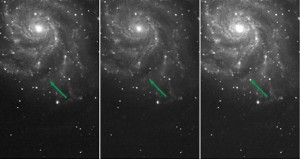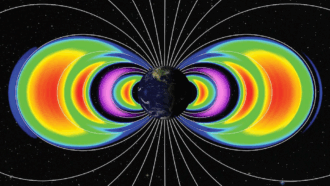Fireworks near the Big Dipper
Astronomers see a star as it explodes
Share this:
- Share via email (Opens in new window) Email
- Click to share on Facebook (Opens in new window) Facebook
- Click to share on X (Opens in new window) X
- Click to share on Pinterest (Opens in new window) Pinterest
- Click to share on Reddit (Opens in new window) Reddit
- Share to Google Classroom (Opens in new window) Google Classroom
- Click to print (Opens in new window) Print

Twenty-one million years ago, a white dwarf star exploded in a burst of light and energy that began racing through space in all directions. In late August, a robotic telescope in California detected evidence of the event. Word went out to stargazers all over the world. Soon, they turned their telescopes to watch the light show.
And they were delighted.
A star explosion is called a supernova. And it’s rare for astronomers to see one that’s so close. (The star that exploded was about 21 million light-years away, which makes it a nearby neighbor. Since a light-year is the distance covered by light in one year, it took 21 million years for evidence of the explosion to reach Earth.) It’s also uncommon to see a supernova from beginning to end, so this one — named PTF 11kly — was a stellar surprise.
“Saying it’s ‘once in a generation’ is very true,” Peter Nugent told Science News. This astronomer works at the Lawrence Berkeley National Laboratory in California. He was part of an international team who made the discovery. He said only three similar supernovas have been witnessed so close to Earth in the past 40 years.
“We think we found it probably 12 hours after it exploded [into view],” Mark Sullivan told Science News. Sullivan is an astronomer at the University of Oxford in England. Like Nugent, he’s part of the international research team, which uses a robotic telescope on Palomar Mountain, about 100 miles from Pasadena, Calif.
The star is part of the Pinwheel Galaxy. It appears near the Big Dipper in the night sky. On August 23, the star was far too faint to be seen by human eyes. Then, on August 24, the star became six times brighter. This change in brightness was picked up by the telescope. Astronomers predicted that the supernova would continue to brighten for about two weeks, when it would be bright enough to see with binoculars (at least for people under clear skies on a moonless night).
Astronomers call the newly discovered explosion a Type Ia supernova. This kind of supernova forms when two stars race around each other. One of the stars is called a white dwarf. These types of stars are superdense: A tablespoon of white-dwarf matter weighs 15 tons. White dwarfs have a powerful gravitational force, so they steal mass from their companion star. Eventually, so much extra mass piles up that the white dwarf star explodes.

Type Ia supernovas, which are about four billion times as bright as the sun, have played an important role in the history of astronomy. Scientists have used these stellar explosions to estimate the distance from Earth to distant galaxies. By studying Type Ia supernovas, scientists also have learned that the universe is expanding — and that this expansion is speeding up.
Scientists are now doing a bit of detective work to see if they can learn more about the supernova. They’re studying older pictures of the part of the sky where the supernova took place to see what the white dwarf and its companion looked like before the dazzling display of fireworks.
POWER WORDS (adapted from the New Oxford American Dictionary and NASA’s “Imagine the Universe”)
supernova A star that suddenly gets brighter because of a catastrophic explosion that ejects most of the star’s mass.
galaxy A system of gas, dust and millions or billions of stars held together by gravity.
type Ia supernova A supernova that results from some binary (paired) star systems in which a white dwarf star gains matter from a companion. The white dwarf eventually gains so much mass that it explodes.
white dwarf A small, very dense star that is typically the size of a planet.
telescope An instrument that makes distant objects appear nearer through the use of lenses or a combination of curved mirrors and lenses.






